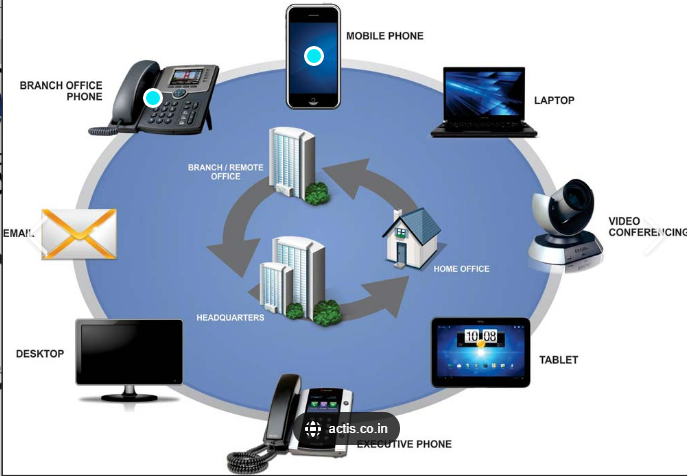Unified-Communications

Unified Communications (UC) integrated to optimize business processes and increase user productivity, UC integration can take many forms, such as: users simply adjusting their habits, manual integration as defined by procedures and training, integration of communications into off-the-shelf tools. Essentially, unified communications (UC) integrates real-time enterprise communication services, which includes components like: Presence: Figuring out if a person is busy or free, Instant messaging, and much more.


For growing organization, diving headfirst into the strategic execution of your operations without reflecting on how you communicate with your team could result in business failure. UC must meet the needs of both the individual users and the business. Understanding some of the basic functions of Unified Communications and how to implement these methods across your team can save you from having to clean up messes, later on, reduce friction in your operations, and foster genuine connections between your employees.
Sweet Caroline
Unified Communications (UC) service that delivers a consistent, multi-device, UI and UX platform can free your company from the need to download, install, and learn new software. The UC provider assures your communications are streamlined, reducing friction within your organization. While freedom is an essential feature of UC, you should not jeopardize your company by investing in a service that may put your business at risk.


The UC will allow you to see your contacts’ online statuses, schedule meetings quickly and easily, as well as start conversations with their colleagues within applications. The UC provider’s features allow you to easily turn the call into a video call to obtain real-time feedback. When you know who is present, you know which skills, perspectives, and insights you can call on from your team. An essential function of UC is knowing which content, tools, people, and conversations are available in your team’s workspace at any given moment.
Snowbird - Linn Anderson
As UC adapts to the future of the workplace, the demand for new technology will only increase. Staying up-to-date with communications platforms may be difficult if you choose features that do not automatically update with their parent programs. Additionally, as the remote workforce continues to grow, an upfront investment in a UC program that adapts to your team’s mobile needs will pay off in the long run. While securing the right UC strategy for your present team is important, choosing a UC solution that anticipates and responds to your organization’s future needs will ensure the greatest long-term success.


Our Unified Communications solution is known as the Cytracom Platform.
Communications is a critical component for everyday business. Voice Over IP (VoIP) has had and incredible impact on businesses by lowering the cost structure for vice services and providing advance features and functionality. UC has taken communications to the next level by adding mobility, desktop integration, and messaging to provide flexibility for businesses and their employees.
Johnny Cash - Ghost Riders in the Sky

The Cytracom Mobile App provides all the features and functionality of the system on a mobile device. This allows you to maintain your business and personal personas on your mobile phone.
Manage your entire office communications ecosystem. Voice presence and business messaging can be managed with the Cytracom Desktop.
Send and receive SMS/MMS messages on the Cytracom Desktop App to other employees or people on their mobile devices
Seamlessly integrate your Cytracom system to Office 365 or Outlook to see presence, click to dial, and manage VoiceMails and faxes.
The Cytracom Desktop combines voice, business messaging and more into a single UC that can be accessed from any PC or Mac browser. It enables your employees to communicate seamlessly wherever they work. They could be working at the office, on the road, or from home and be able to manage calls, monitor teams presence, manage voicemail, share files, and use business messaging to communicate.

Unified Communications (UC) solves challenges that businesses encounter.
Businesses that have workers on the go, such as field sales, and remote workers need the full functionality of a robust UC system.
UC system needs to be able to grow with workers and avoid legacy-based hardware that becomes obsolete.
Simplicity for the UC is needed that can easily be implemented and intuitive for users
Serving all generations with UC allows employees to have the communication tools that meet their needs.

UC most important features are business messaging, mobility, and management.
Business messaging -- Send and receive business messages with other employees or SMS with people outside the business.
Mobility -- Users can take all their key communications tools with them wherever they have a laptop or desktop.
Management -- Cytracom Desktop give users the ability to manage all their communications. This includes voice calls, business messaging, user presence, contact and more. All these communications are done through a unified intuitive interface.



Phones are a critical part of any business communications strategy, and voice communications is just as important today in the digital world of email, text, social, media. Business must continually review telephone costs, features, and benefits to retain a competitive edge. This means reviewing current phone systems, such as Private Branch Exchange (PBX) and premises based IP-PBX systems. You should be able to identify the appropriate VoIP solutions for better long-term high-quality business phone service.
John Denver - Take Me Home Country Road



Ring of Fire - Johnny Cash
